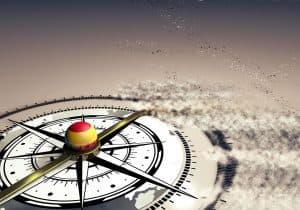When you use a trail camera to monitor the movement of deer, small details can make a huge difference to the quality of the images. These tips to capture better trail camera images will help you to take better pictures and improve your chances of getting a trophy buck.
Hunting techniques have changed due to the use of game cameras. Modern trail cameras are packed with features, yet they are very easy to use. You can take your trail camera photography to the next level by following some simple guidelines. Let’s take a closer look at these tips to capture better trail camera images:
Monitor the wind direction
Trail cameras capture images of bucks occasionally. You may not be able to get photos every day, and this seems to happen without any discernable pattern. However, if you monitor the wind direction by positioning some flagging tape in the background of every camera position, you may be able to detect a pattern.
You may find that bucks don’t approach some camera locations unless the wind is blowing from a particular direction. The flags that can be seen in each frame make it easy for you to determine the wind direction that bucks seem to prefer. This also points towards the locations where you need to hunt.
Glare can ruin trail camera images
Your trail camera (for example: MOULTRIE M 1100I GAME CAMERA ) images can be ruined by glare, and this can happen regardless of the direction in which you point your camera. The glare may ruin your images at some time of the day.
You can avoid this problem by positioning your camera a little higher than normal on a stick or tree. Place your camera close to the height of your head and wedge a stick behind it to ensure that images will be taken at a downward angle.
This will help to ensure that the glare from the sun will not affect your camera and you will get great images.
Avoid mixing up your SD cards
If you have been using wild game cameras for a while, you may possess lots of SD cards that you use in multiple cameras. Keep track of your SD cards to ensure that you will not insert a card that contains images from one location into another camera.
To prevent this, use different portable cases for storing used SD cards and those that are meant to be carried to camera locations.
To avoid inserting a card from one camera into a different camera, keep blank SD cards face up and keep used cards face-down in a case. You can also use a permanent marker to number your cameras and SD cards.
Align your camera angle with the trail
If you align your camera angle with the trail, the motion sensors will have more time to trigger. This will improve your chances of capturing images of deer. The deer will walk within the range of the motion sensors for much longer instead of only crossing the field of view.
This will also improve your chances of capturing an image of the entire deer instead of only capturing its tail end.
However, this may not be the right approach if you are trying to cover a particular target such as a feeder or scrape.
Minimize your scent
A few simple steps can help you to reduce your scent, which can alarm the deer:
Check your deer cameras on rainy days because rain eliminates your scent.
Wear rubber boots when you visit your trail cameras.
Wear scent-free neoprene gloves while handling your hunting cameras.
Spray your game cams with a scent eliminator and wipe them with a clean towel. Make sure that the spray doesn’t get on the lens.
Record the coordinates of each trail camera
You can use a handheld GPS unit or your smartphone to record the coordinates of each of your trail cameras. This can be a big help if you like to hide your cameras and don’t visit them again for weeks.

The bushes keep growing and changing constantly, so these steps can help you to avoid losing an expensive trail camera.
You can load the coordinates into Google Earthand keep updating them all through the year. Google Earth acts as a powerful scouting tool, giving you a 3D-like view of the area. It can also help you to identify areas that have not been covered.
Set up cameras in remote areas
Bucks look for remote areas where there is lots of nutritious food and where human interference is limited. Yearlings and fawns also prefer undisturbed areas where there is plenty of food.
That’s why it makes senses to set up some cameras in areas that are far away from the beaten track.
If you happen to find an area like this, tread lightly and set up a few cameras to see if you can spot a good buck.
Use both time lapse and trail modes
First look for deer movements over a wide area. Use trail cameras that are capable of time-lapse photography to cover food plots, fields and other areas where deer are likely to be.
Set up cameras to capture images after every 10 or 20 seconds in the morning and evening. This may allow your batteries to last for weeks instead of days.
Once you have reviewed the time lapse images and found the routes that the deer are taking, you can set up regular trail cameras to get images of particular bucks that interest you.
These strategies will help you to identify areas where the best bucks stay and the routes they take. They will also improve your chances of getting a prize buck. Good luck!
